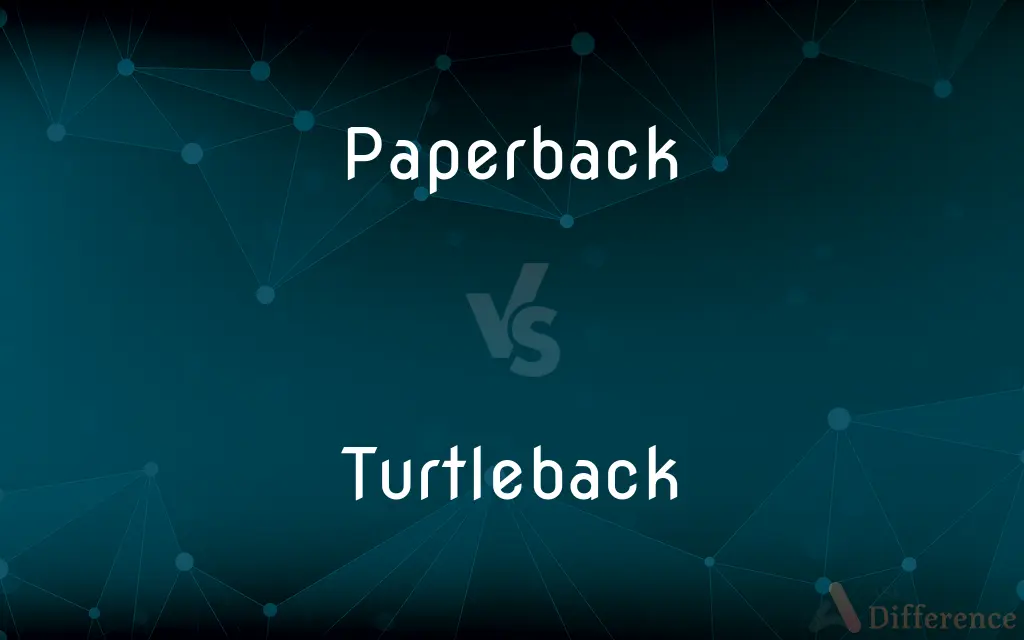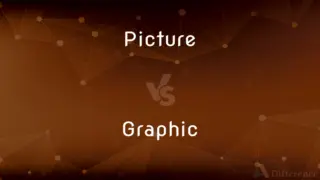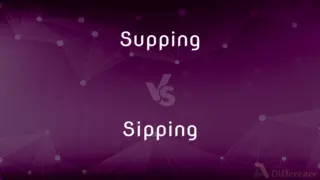Paperback vs. Turtleback — What's the Difference?
By Fiza Rafique & Maham Liaqat — Updated on March 28, 2024
Paperback books are bound with a flexible paper cover, while Turtleback books have a durable, library binding for extended use.

Difference Between Paperback and Turtleback
Table of Contents
ADVERTISEMENT
Key Differences
Paperback books, known for their lightweight and flexibility, feature covers made of thick paper or light cardboard. This construction makes them affordable and widely available, catering to a broad audience of readers. Turtleback books, on the other hand, are designed for durability, with a unique library binding that withstands frequent handling and usage, making them ideal for public libraries and school settings.
The primary appeal of paperbacks is their portability and lower cost, making them a popular choice for casual reading and travelers. They are easily accessible and can be found in various genres. Turtleback books, while less common in casual settings, are preferred in environments where books are heavily used, as their reinforced binding and hardcovers protect the pages from wear and tear.
When it comes to variety, paperbacks offer a vast selection of titles ranging from bestsellers to niche publications. Their affordability encourages readers to explore new genres without a significant financial commitment. Turtleback books are typically limited to titles that are expected to endure heavy circulation, such as educational materials, classics, and popular children’s books.
The aesthetic and tactile experience of reading also differs between the two. Paperbacks provide a certain ease and comfort for leisure reading, fitting comfortably in the hands and bags. Turtleback books, with their sturdy construction, offer a sense of permanence and resilience, suitable for long-term use and collections meant to be passed down.
The choice between paperback and Turtleback depends on the intended use and personal preference. While paperbacks are favored for their convenience and affordability, Turtleback books are chosen for their durability and longevity, serving different needs in the world of reading.
ADVERTISEMENT
Comparison Chart
Cover Material
Thick paper or light cardboard
Durable, library binding
Durability
Less durable, prone to wear
Highly durable, designed for heavy use
Cost
Generally less expensive
More expensive due to durable construction
Availability
Wide availability in various genres
Selected titles, focusing on high-usage books
Intended Use
Casual reading, travel
Libraries, schools, frequent use
Aesthetic Appeal
Flexible and portable
Sturdy and resilient
Selection Variety
Broad selection across genres
Limited to popular or educational titles
Compare with Definitions
Paperback
More affordable than hardcover editions.
I choose paperbacks to save money on new authors I'm exploring.
Turtleback
A book with a hard, durable library binding.
The library purchases Turtleback books for their durability.
Paperback
Light and portable, ideal for casual reading.
The paperback edition fits perfectly in my bag.
Turtleback
Designed for extended use and frequent handling.
Turtleback editions are perfect for classroom settings.
Paperback
Available in a wide range of genres and titles.
The bookstore offers thousands of paperbacks in various genres.
Turtleback
Selected titles, mainly high-usage or educational.
Classic novels are often available in Turtleback for schools.
Paperback
Prone to wear but easily replaceable.
My favorite paperback has dog-eared pages from frequent reading.
Turtleback
More expensive but lasts longer.
Investing in a Turtleback saves money over time for popular titles.
Paperback
A book with a soft cover made of paper or cardboard.
She prefers buying paperbacks for her beach reads.
Turtleback
Offers a sturdy reading experience.
Turtleback books feel solid and endure through many readings.
Paperback
A paperback, also known as a softcover or softback, is a type of book characterized by a thick paper or paperboard cover, and often held together with glue rather than stitches or staples. In contrast, hardcover or hardback books are bound with cardboard covered with cloth, plastic, or leather.
Turtleback
(Nautical) An arched structure erected over the deck of a ship as protection from heavy seas.
Paperback
A book having a flexible paper binding.
Turtleback
(Archaeology) A stone tool with a convex side.
Paperback
A book with flexible binding.
Turtleback
Anything having the shape of a turtle's back (that is, its shell).
Paperback
(of a book) Having flexible binding.
Turtleback
(nautical) A convex deck at the bow or stern of a vessel, designed to shed seawater quickly.
Paperback
To issue or publish (a book) in a paperback edition.
Turtleback
An armor layout with an armored deck which slopes downwards towards the sides of the ship and connects to the lower edge of the main belt armor, designed to deflect shells striking the ship on trajectories close to horizontal.
Paperback
A book with paper covers; - contrasted with hardback or hardcover.
Turtleback
A primitive stone celt of a form suggesting the back of a turtle.
Paperback
Having a flexible binding; - of books. Contrasted to hardcover or hardbacked or hardbound.
Turtleback
A library binding of a mass market paperback with a generic hardcover.
Paperback
A book with paper covers
Turtleback
Any plant of the genus Psathyrotes of annual and perennial forbs and low subshrubs native to dry areas of southwestern North America.
Paperback
(of books) having a flexible binding
Turtleback
A rude stone celt of a form suggesting the back of a turtle.
Turtleback
A convex deck at the bow or stern of a vessel, so made to shed the seas quickly.
Common Curiosities
Are Turtleback books more expensive than paperbacks?
Yes, Turtleback books are typically more expensive due to their durable construction and intended for heavy handling.
What is a Turtleback book?
Turtleback books are designed with a durable, library binding for extended use, ideal for libraries and schools.
What is a paperback book?
A paperback is a book with a flexible, often paper or light cardboard cover, designed for affordability and ease of handling.
Where can I buy Turtleback books?
Turtleback books are usually available through educational suppliers, libraries, or stores specializing in durable books.
Why choose a paperback over a Turtleback book?
Choose a paperback for casual reading, affordability, and portability; Turtleback for durability and frequent use.
Why are paperbacks so popular?
Paperbacks are popular for their affordability, portability, and wide selection of titles.
Can I find all titles in Turtleback format?
No, Turtleback books are selectively produced for titles expected to endure heavy use, like educational materials and classics.
Do Turtleback books last longer?
Yes, Turtleback books are specifically designed to withstand frequent use and handling, making them more durable.
Do libraries prefer Turtleback books?
Libraries often prefer Turtleback books for their durability, especially for titles that see a lot of circulation.
Is the print quality different in Turtleback books?
The print quality is generally the same, but the focus is on the book’s durability rather than its aesthetic qualities.
Why might schools use Turtleback books?
Schools use Turtleback books to ensure textbooks and reading materials withstand the wear and tear of daily student use.
Can Turtleback books be used for casual reading?
While they can be used for any reading, their higher cost and bulk make them less common for casual reading.
Is there a difference in content between paperback and Turtleback editions?
No, the content is the same, but the binding and cover durability differ.
Are paperbacks suitable for collectors?
Paperbacks are less durable and may not be the first choice for collectors, who often prefer hardcovers or special editions.
Is the weight of a Turtleback book significantly more than a paperback?
Turtleback books are heavier due to the durable binding and cover, which may affect portability compared to paperbacks.
Share Your Discovery

Previous Comparison
Picture vs. Graphic
Next Comparison
Supping vs. SippingAuthor Spotlight
Written by
Fiza RafiqueFiza Rafique is a skilled content writer at AskDifference.com, where she meticulously refines and enhances written pieces. Drawing from her vast editorial expertise, Fiza ensures clarity, accuracy, and precision in every article. Passionate about language, she continually seeks to elevate the quality of content for readers worldwide.
Co-written by
Maham Liaqat













































